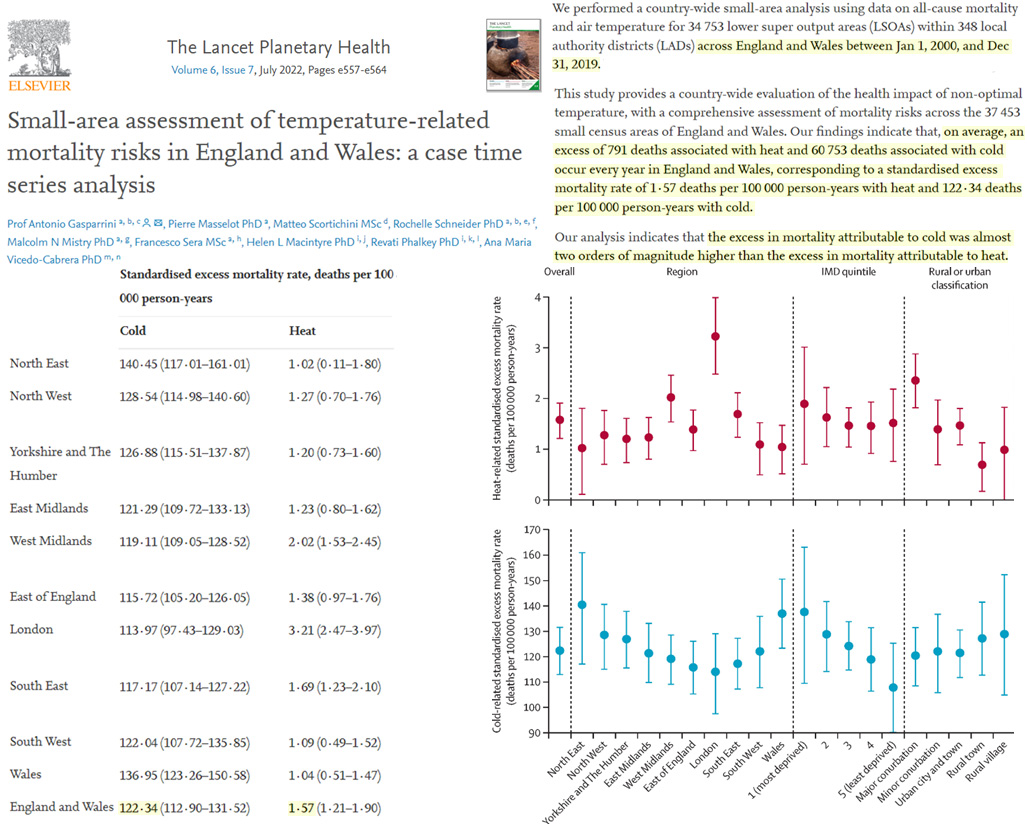By Kenneth Richard
A new Lancet study ominously reports that from 2000 to 2019 in England and Wales there were an average of 791 heat-related excess deaths and 60,753 cold-related excess deaths each year. That’s an excess death ratio of about 85 to 1 for cold temperatures.
Adjusted as deaths per 100,000 person-years, the annual ratio is 1.57 heat-related deaths vs. 122.34 cold-related excess deaths throughout the 21st century.
“Our analysis indicates that the excess in mortality attributable to cold was almost two orders of magnitude higher than the excess in mortality attributable to heat.”

Image Source: Gasparrini et al., 2022
Several other new studies report heavily skewed ratios for cold- vs. heat-related excess deaths in the modern climate.
Excess mortality due to cold temperatures was 32 times higher than for heat in Switzerland from 1969-2017.
“Total all-cause excess mortality associated with nonoptimal temperatures was 9.19% [95% confidence interval (CI): 7.72, 10.47], which translates to 274,578 (95% CI: 230,657, 312,761) temperature-related excess deaths in Switzerland between 1969 and 2017 (Table 2; Table S4). Cold-related mortality represented a larger fraction in comparison with heat, with 8.91% (95% CI: 7.46, 10.21) vs. 0.28% (95% CI: 0.18, 0.37).”
Excess mortality due to cold temperatures was 7.6 times higher than for heat in 326 Latin American cities from 2002 to 2015.
“Climate change and urbanization are rapidly increasing human exposure to extreme ambient temperatures, yet few studies have examined temperature and mortality in Latin America. We conducted a nonlinear, distributed-lag, longitudinal analysis of daily ambient temperatures and mortality among 326 Latin American cities between 2002 and 2015. We observed 15,431,532 deaths among ≈2.9 billion person-years of risk. The excess death fraction of total deaths was 0.67% (95% confidence interval (CI) 0.58–0.74%) for heat-related deaths and 5.09% (95% CI 4.64–5.47%) for cold-related deaths.”
Excess mortality due to cold temperatures was 6.8 times higher than for heat in a city in India (Pune) from 2004 to 2012.
“We applied a time series regression model to derive temperature-mortality associations based on daily mean temperature and all-cause mortality records of Pune city [India] from year January 2004 to December 2012. The analysis provides estimates of the total mortality burden attributable to ambient temperature. Overall, 6∙5% [95%CI 1.76–11∙43] of deaths registered in the observational period were attributed to non-optimal temperatures, cold effect was greater 5.72% [95%CI 0∙70–10∙06] than heat 0∙84% [0∙35–1∙34].”
Excess mortality due to cold temperatures was 42 times higher than for heat in China in 2019.
“We estimated that 593·9 (95% UI:498·8, 704·6) thousand deaths were attributable to non-optimal temperatures in China in 2019 (PAF=5·58% [4·93%, 6·28%]), with 580·8 (485·7, 690·1) thousand cold-related deaths and 13·9 (7·7, 23·2) thousand heat-related deaths.”
Excess mortality due to cold temperatures was 46 times higher than for heat in Mexico from 1998-2017.
Cohen and Dechezleprêtre, 2022 (full paper)
“We examine the impact of temperature on mortality in Mexico using daily data over the period 1998–2017 and find that 3.8 percent of deaths in Mexico are caused by suboptimal temperature (26,000 every year). However, 92 percent of weather-related deaths are induced by cold (<12 degrees C) or mildly cold (12–20 degrees C) days and only 2 percent by outstandingly hot days (>32 degrees C). Furthermore, temperatures are twice as likely to kill people in the bottom half of the income distribution.”
Excess mortality due to cold temperatures was 12.8 times higher than for heat “across 612 cities within 39 countries over the period 1985–2019.”
“Here, we perform a comprehensive assessment of temperature-related mortality risks using ground weather stations observations and state-of-the-art reanalysis data across 612 cities within 39 countries over the period 1985–2019. … In general, across most countries, the estimates of the excess mortality are very similar, with a global-level excess of 0.53% (95% eCI 0.50–0.56) versus 0.49% (0.43–0.53) for heat, and 6.02% (5.80–6.18) versus 6.25% (6.05–6.41) for cold, from ground stations and ERA5-Land data, respectively (‘Global’ in Fig. 5 and Table S3). These percentages correspond to 357,729 (95% eCI 335,138–376,498) versus 326,032 (288,069–357,247) for heat, and 4,030,793 (3,880,068–4,137,579) versus 4,186,014 (4,051,321–4,293,311) for cold.”
If there really is a concern for human health and extending life spans, there should be much more emphasis placed on reducing the costs of energy to heat homes, as well as minimizing exposure to cold temperatures.
Instead, the invariable focus is on the dangers of “climate change” or heat waves that put humanity at a tiny fraction of the risk that cold temperatures do.
Warmth saves lives. Cold kills. This has been true throughout human history, and it is no less true today.




